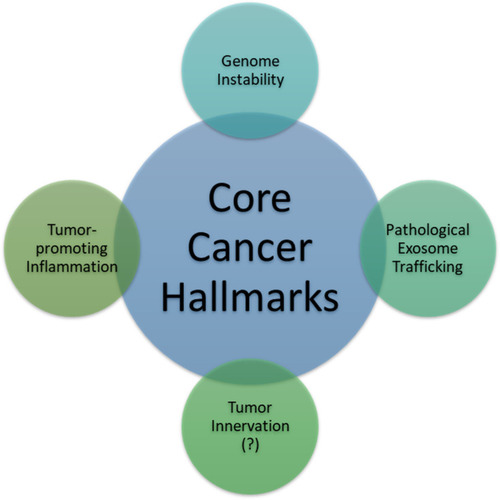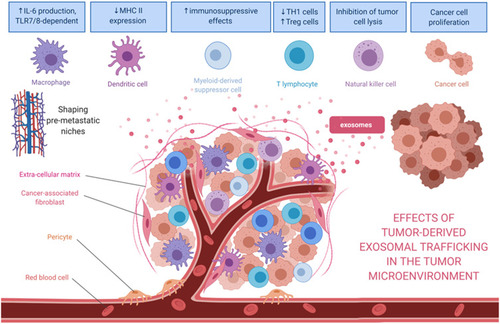Figures & data
Figure 1 Two established enabling characteristics (genome instability or mutation and tumor-promoting inflammation): one investigating feature (tumor innervation) and one hitherto proposed enabling characteristic, that is, pathological exosome trafficking. Enabling characteristics are defined as the capabilities possessed by most cancer types to foster and/or expedite the acquisition of one or some core hallmarks of cancer.

Table 2 Paracrine Exosome Trafficking Employed by Acute Myeloid Leukemia (AML) as an Example and Its Specific Functional Outcomes
Table 3 Representative Exosomal Cargoes Other Than miRNAs (Such as Proteins, Lipids, Signaling Molecules, DNA, Mitochondrial DNAs, circRNAs, lncRNAs, Integrin, and Enzyme), Which are Involved in Cancer Progression or in the Interplay in Anticancer Immunity or Served as a Biomarker in Various Cancer Types
Figure 2 Effects of tumor-derived exosomes and their horizontal paracrine trafficking to impact on the tumor microenvironment. For example, breast cancer-derived exosomes modify the TME through the suppression of T-cell proliferation and NK cell cytotoxicity. Also, the exosomal content (eg, miR-1246 or miR-155) might contribute to the chemoresistance or hormone-resistance in tumor cells. Exosomes secreted by liposarcoma cells containing miR-25-3p and miR-92a-3p have been found to stimulate IL-6 secretion in tumor-associated macrophages, leading to liposarcoma progression. miR-34a in the released exosomes enhances the neural differentiation of Ewing sarcoma. Myeloma-derived exosomes could modify the microenvironment, affecting various recipient cells such as bone marrow endothelial cells or myeloid‐derived suppressor cells. In the case of myeloma, these exosomal cargoes include miR-135b, miR18a, and let7b. After being internalized by recipient cells, miRs could bind to their target genes and trigger numerous pathways to facilitate tumor progression.

Table 4 Published Clinical Studies on Exploiting Exosomes as Diagnostic, Prognostic, or Predictive Biomarkers in Various Types of Cancer
Table 5 Ongoing Human Studies Investigating Exosomes as a Biomarker in Various Types of Cancer, as Registered in ClinicalTrials.gov
